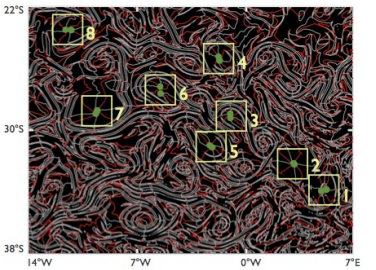Black Hole Analogue Discovered in South Atlantic Ocean
Black holes are regions of spacetime in which gravity is strong enough to prevent anything escaping, even light. These strange objects were first discovered in the early 20th century as mathematical solutions to the equations of general relativity. (It was not until much later that astronomers began to gather observational evidence of their existence.)

One of the curious features of general relativity is that the same mathematics crops up in various other situations. In recent years, for example, physicists have worked out how to create invisibility cloaks by steering light around objects using metamaterials.
Black holes steer light in the same way by bending space-time. In fact, the mathematics that describe both systems are formally equivalent. Because of that, it should come as no surprise that engineers have used metamaterials to create analogues of black holes that prevent light escaping.
Today, George Haller at the Swiss Federal Institute of Technology in Zürich and Francisco Beron-Vera at the University of Miami in Florida have found another analogue of a black hole, this time in the world of turbulence.
The vortices that can form in turbulent water are a familiar sight. Edgar Allan Poe described just such a whirlpool in his short story “A Descent into a Maelstrom” which he published in 1841:
“The edge of the whirl was represented by a broad belt of gleaming spray; but no particle of this slipped into the mouth of the terrific funnel… “
In this passage, Poe describes one of the crucial feature of these rotating bodies of fluid: that they can be thought of as coherent islands in an incoherent flow. As such, they are essentially independent of their environment, surrounded by a seemingly impenetrable boundary and with little, if any, of the fluid inside them leaking out.
If you’re thinking that this description has a passing resemblance to a black hole, you’d be right. Haller and Beron-Vera put this similarity on a formal footing by describing the behaviour of vortices in turbulent fluids using the same mathematics that describe black holes.
In this picture, Poe’s “broad belt of gleaming spray” is exactly analogous to a photon sphere around a black hole. This is a surface of light which encircles a black hole without entering it.
Haller and Beron-Vera go on to show that each vortex boundary in a turbulent fluid contains a singularity, just like an astrophysical black hole.
That has important implications for the study of fluids and the identification of vortices, which are otherwise tricky to define and spot. In this case, it is simply question of looking for the singularity and the boundary that surrounds it.
And that’s exactly what Haller and Beron-Vera have done in the pattern of currents in the south west Indian Ocean and the South Atlantic. A well-known phenomenon in this part of the world is called the Agulhas leakage which comes from the Agulhas current in the Indian Ocean. “At the end of its southward flow, this boundary current turns back on itself, creating a loop that occasionally pinches off and releases eddies (Agulhas rings) into the South Atlantic,” they say.
These guys used satellite images of the South Atlantic Ocean from between November 2006 and February 2007 to look for vortices using a set of simple computational steps that spots black hole analogues.
In this three-month period they found eight candidates, two of which turned out to be black hole analogues containing photon spheres. “We have found exceptionally coherent material belts in the South Atlantic, filled with analogs of photon spheres around black holes,” they conclude.
That’s an interesting result that could have significant implications for our understanding of the way ocean currents transport material. Since anything that gets into these black holes cannot get out, this should trap any garbage, oil or indeed water itself, moving it coherently over vast distances. “Beyond the mathematical equivalence, there are also observational reasons for viewing coherent…eddies as black holes,” say Haller and Beron-Vera.
The work also raises the possibility that black hole analogues will occur in other situations, such as in hurricanes and not just on Earth. By this way of thinking, the Great Red Spot on Jupiter might well be the most famous black hole in the Solar System.
Ref: http://arxiv.org/abs/1308.2352 : Coherent Lagrangian Vortices: The Black Holes Of Turbulence
Keep Reading
Most Popular
Large language models can do jaw-dropping things. But nobody knows exactly why.
And that's a problem. Figuring it out is one of the biggest scientific puzzles of our time and a crucial step towards controlling more powerful future models.
The problem with plug-in hybrids? Their drivers.
Plug-in hybrids are often sold as a transition to EVs, but new data from Europe shows we’re still underestimating the emissions they produce.
Google DeepMind’s new generative model makes Super Mario–like games from scratch
Genie learns how to control games by watching hours and hours of video. It could help train next-gen robots too.
How scientists traced a mysterious covid case back to six toilets
When wastewater surveillance turns into a hunt for a single infected individual, the ethics get tricky.
Stay connected
Get the latest updates from
MIT Technology Review
Discover special offers, top stories, upcoming events, and more.